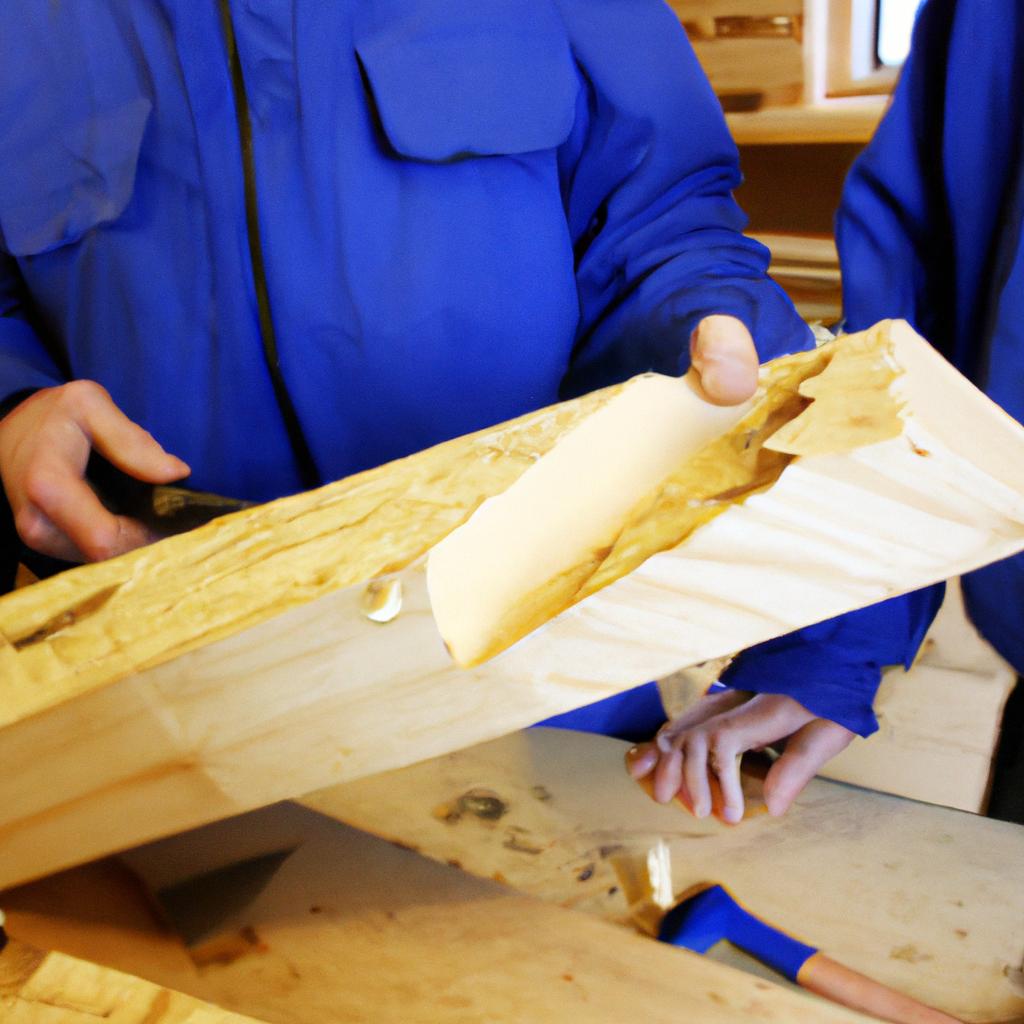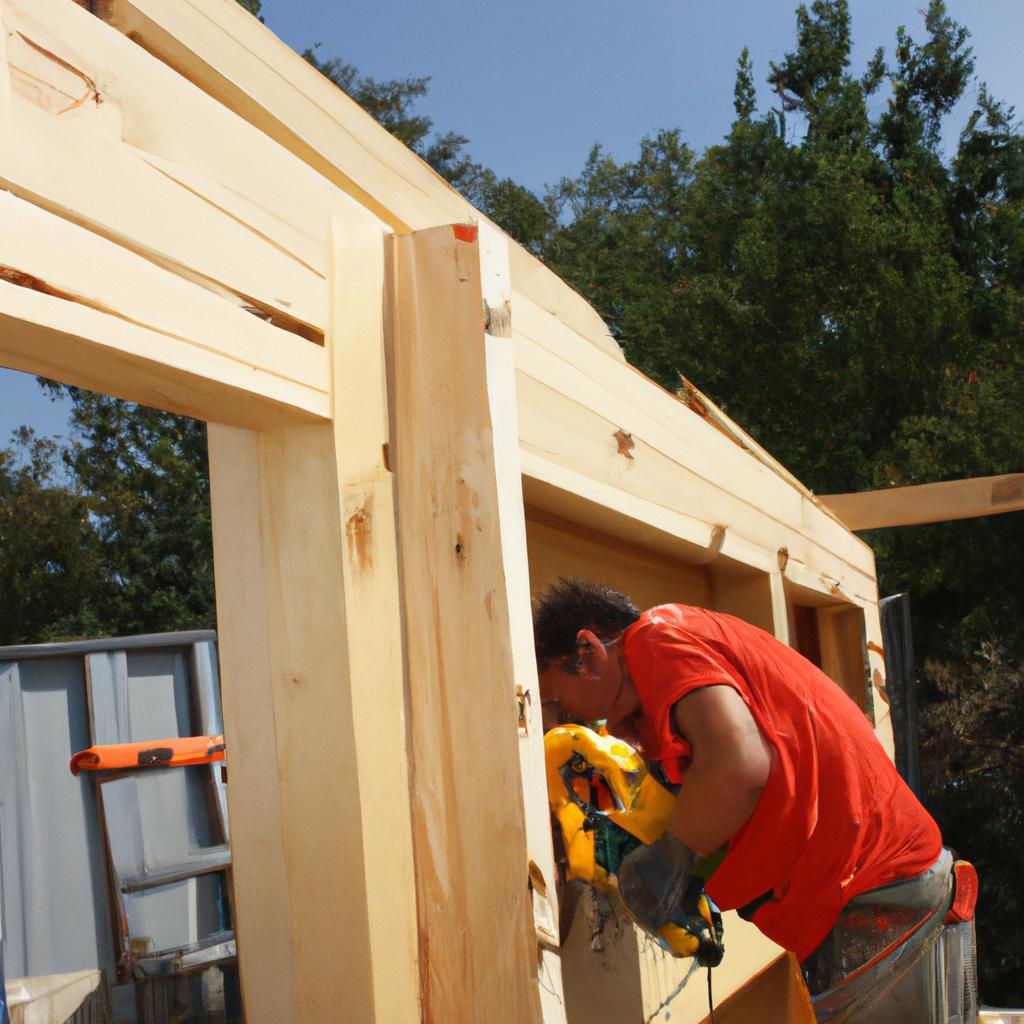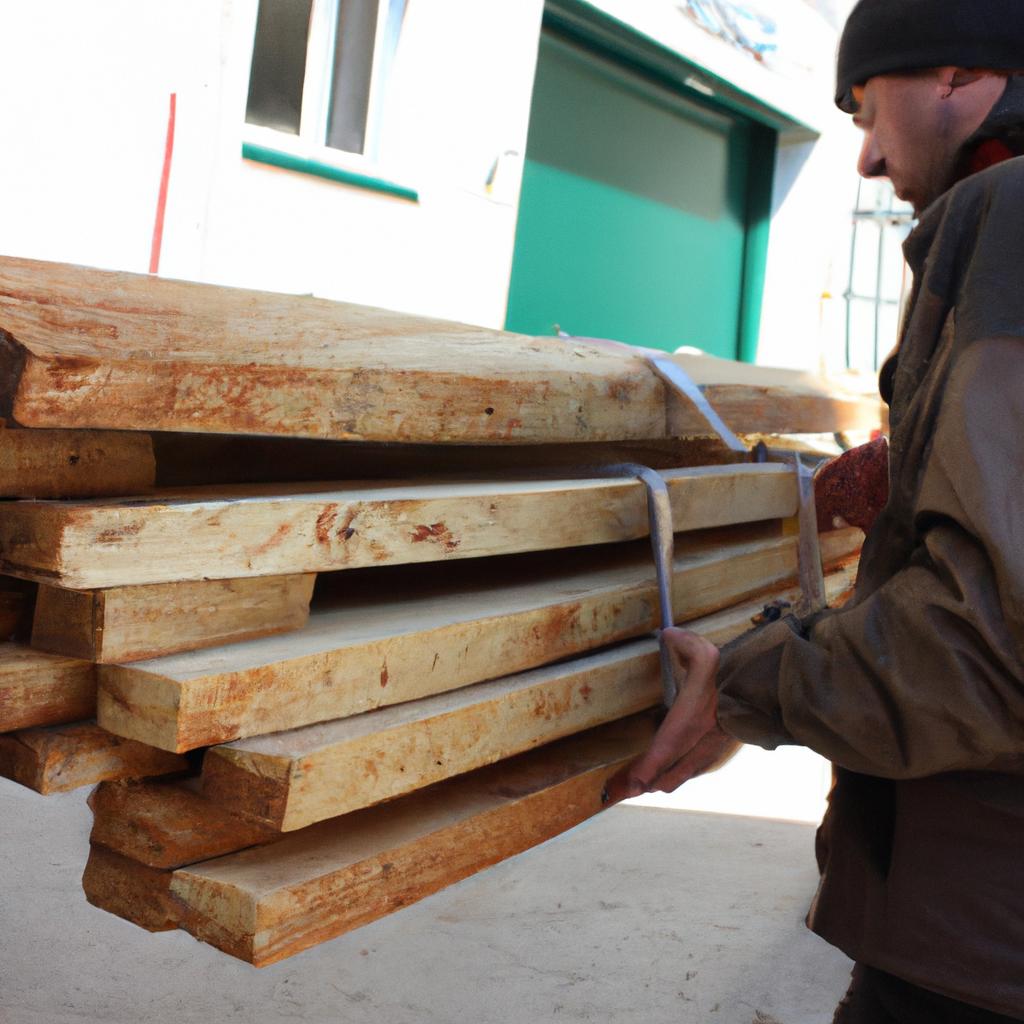The use of treated lumber in construction and outdoor projects has long been a standard practice due to its durability and resistance against rot, insects, and decay. However, concerns regarding the environmental impact of treated lumber have led many individuals and organizations to seek alternative options that are more sustainable. One such example is the case study of Green Builders Inc., a construction company based in California. Facing increasing pressure from environmentally conscious clients, they decided to explore alternatives to treated lumber for their latest project – a residential development focused on green building practices.
In this article, we will examine various sustainable alternatives to treated lumber that can be used in construction and outdoor applications. The aim is not only to reduce the negative ecological effects associated with conventional wood treatments but also to promote the use of environmentally friendly materials without compromising structural integrity or longevity. By exploring these alternatives, it becomes evident that there are viable options available which offer comparable performance while minimizing harm to ecosystems and human health. Through an analysis of case studies like Green Builders Inc., we can gain insight into the practicality and benefits of adopting these sustainable materials in real-world scenarios.
Recycled Plastic Lumber
Imagine a world where discarded plastic bottles and containers could be transformed into durable, long-lasting building materials. This is the reality of recycled plastic lumber, an environmentally-friendly alternative to traditional treated lumber. By repurposing post-consumer plastics, such as high-density polyethylene (HDPE), this innovative material offers a host of benefits for both builders and the environment.
One compelling example of how recycled plastic lumber can be used effectively is in the construction of outdoor decking. A case study conducted by a leading sustainable design firm found that replacing conventional wooden decks with recycled plastic lumber not only reduced deforestation but also eliminated the need for chemical treatments like pesticides and preservatives. The result was a low-maintenance deck that resisted rot, decay, and insect damage while minimizing environmental impact.
- Reduced waste: Every year, millions of tons of plastic end up in landfills or pollute our oceans. Using recycled plastic lumber diverts this waste from disposal sites and gives it new life.
- Longevity: Recycled plastic lumber has exceptional durability compared to traditional wood products. It does not splinter, warp, or crack over time.
- Low maintenance: Unlike treated lumber that requires regular staining or sealing to maintain its appearance and structural integrity, recycled plastic lumber is virtually maintenance-free.
- Environmental benefits: By choosing recycled plastic lumber over traditional options, you are reducing reliance on timber resources and decreasing carbon emissions associated with manufacturing processes.
In addition to these advantages, let us now turn our attention to comparing recycled plastic lumber with another sustainable option – bamboo.
Bamboo
Recycled Plastic Lumber has proven to be a sustainable alternative to treated lumber due to its durability and environmental benefits. Now, let’s explore another viable option: Bamboo.
Bamboo is an incredibly versatile material that offers numerous advantages as a substitute for traditional treated lumber. With its fast growth rate and ability to regrow quickly after harvesting, bamboo is considered one of the most renewable resources available. This makes it an ideal choice for those looking to reduce their ecological footprint while still enjoying high-quality construction materials.
One example showcasing the potential of bamboo as a sustainable alternative involves a housing project in Asia. The developers utilized bamboo extensively throughout the construction process, incorporating it into both structural elements and finishing touches. Not only did this approach significantly reduce the project’s environmental impact, but it also showcased bamboo’s adaptability and aesthetic appeal.
When considering the use of bamboo as an alternative to treated lumber, several key points should be taken into account:
- Environmental Benefits:
- Bamboo grows rapidly, typically reaching maturity within three to five years.
- Its extensive root system prevents soil erosion and aids in carbon sequestration.
- Bamboo cultivation requires minimal water usage compared to other timber sources.
- Unlike conventional wood species, bamboo does not require chemical treatment or preservatives.
To further illustrate the attributes of bamboo compared to treated lumber, consider the following table:
| Aspect | Treated Lumber | Bamboo |
|---|---|---|
| Renewability | Limited | Highly renewable |
| Growth Rate | Slow | Rapid |
| Durability | Subject to decay | High resistance |
| Carbon Footprint | High | Low |
As evident from the comparison above, bamboo surpasses treated lumber on multiple fronts when it comes to sustainability and performance. By embracing alternatives like recycled plastic lumber and bamboo, individuals can contribute towards preserving natural resources while constructing buildings with longevity in mind.
Transitioning into the subsequent section about “Engineered Wood Products,” it is worth exploring further innovative solutions that offer both ecological benefits and structural reliability.
Engineered Wood Products
Section: Engineered Wood Products
In recent years, the demand for sustainable construction materials has led to an increased interest in alternative options to treated lumber. One such option is engineered wood products (EWPs), which offer both environmental benefits and structural advantages over traditional timber. To illustrate this point, let’s consider a hypothetical case study where a commercial building project seeks to minimize its carbon footprint by using EWPs.
Case Study: Green Office Building Project
The architects of a new office complex prioritize sustainability and seek alternatives to treated lumber that can meet their design requirements while minimizing environmental impact. After careful consideration, they opt for engineered wood products as the primary material for the project. This decision results in several notable benefits:
- Reduced deforestation: By utilizing EWPs, fewer trees need to be harvested compared to traditional timber construction methods. This helps preserve forests and protect biodiversity.
- Lower embodied energy: The production process of engineered wood consumes less energy than manufacturing steel or concrete, making it an eco-friendly choice with lower greenhouse gas emissions.
- Enhanced durability: Engineered wood products are designed to resist warping, shrinking, and cracking better than natural timber. This improves the longevity of structures made from these materials.
- Improved strength-to-weight ratio: Engineers find that engineered wood offers excellent load-bearing capacity while being lighter than solid timber or other conventional building materials.
To further understand the characteristics and applications of engineered wood products, refer to the following table:
| Type | Description | Common Uses |
|---|---|---|
| Glulam | Laminated beams created by bonding multiple layers | Roofing systems |
| Cross-laminated timber (CLT) | Solid panels formed by stacking alternating layers of boards | Walls and floors |
| Laminated veneer lumber (LVL) | Consists of thin veneers glued together | Beams, headers, and columns |
| Oriented strand board (OSB) | Engineered panel made from compressed wood strands | Sheathing, subfloors |
In conclusion to this section on engineered wood products, it is evident that they offer a viable and sustainable alternative to treated lumber. The aforementioned case study demonstrates how using EWPs can contribute to reducing deforestation, lowering embodied energy, enhancing durability, and improving the strength-to-weight ratio in construction projects. However, our exploration of alternatives does not end here. In the subsequent section, we will delve into another popular option: Cedar.
Transition sentence: Now let’s examine the benefits of utilizing Cedar as an alternative material for construction projects seeking sustainability.
Cedar
Transition from the previous section:
Having explored engineered wood products, let us now shift our focus to another popular alternative to treated lumber: cedar. Renowned for its natural beauty and durability, cedar has long been favored by homeowners and builders alike.
Section: Cedar
Cedar is an exceptional choice for those seeking a sustainable and aesthetically pleasing option for their construction projects. To illustrate its benefits, consider the following hypothetical case study: A family in the Pacific Northwest decides to build a deck using cedar instead of treated lumber. They are not only drawn to cedar’s resistance against decay but also appreciate its distinct reddish-brown color that complements their home’s surroundings.
When comparing cedar to traditional treated lumber, several advantages become apparent:
- Durability: Cedar possesses natural oils that make it resistant to rotting, insects, and moisture damage.
- Sustainability: Unlike chemically-treated lumber, which can release harmful toxins into the environment over time, cedar is a renewable resource that requires minimal processing.
- Versatility: Cedar is highly versatile and suitable for various applications such as decking, siding, fencing, and outdoor furniture.
- Visual Appeal: The unique grains and rich colors of cedar elevate the aesthetic appeal of any project while adding warmth and character.
To further highlight these aspects, here is a table summarizing some key attributes of cedar compared to treated lumber:
| Key Attributes | Cedar | Treated Lumber |
|---|---|---|
| Durability | High | Moderate |
| Environmental Impact | Low | High |
| Maintenance | Minimal | Regular |
| Aesthetic Value | Natural Beauty | Standard |
As evident from this comparison, choosing cedar over treated lumber offers numerous benefits both in terms of sustainability and visual appeal.
In preparation for our next discussion on metal as an alternative material choice, it is important to note that each material has its own unique strengths and considerations. By considering the specific requirements of your project alongside these alternatives, you can make an informed decision that aligns with your sustainability goals and personal preferences.
Transition to the subsequent section on “Metal”:
Moving forward, let us now explore metal as another viable alternative for construction projects. The durability and versatility of metal offer distinct advantages worth examining in detail.
Metal
In the quest for sustainable alternatives to treated lumber, metal is another viable option worth considering. While not as commonly used in residential construction, metal offers unique advantages that make it an attractive choice for certain applications.
Example: Imagine a small beachfront cabin designed to withstand harsh coastal conditions. In this scenario, using metal instead of traditional wood framing can provide enhanced durability and resistance against saltwater corrosion.
Advantages of Metal:
Metal possesses several key qualities that set it apart from other materials, making it a compelling alternative to treated lumber. Consider the following benefits:
- Strength and Durability: Metal structures are known for their strength and longevity. They can withstand extreme weather conditions such as high winds or heavy snow loads.
- Fire Resistance: Unlike wood, which is highly combustible, metal has inherent fire-resistant properties. This makes metal structures less vulnerable to fires and reduces the risk of damage or loss.
- Minimal Maintenance: Metal requires minimal maintenance compared to wood. It does not rot, warp, or decay over time, reducing the need for frequent repairs or replacements.
- Eco-Friendly Options: Many types of metals used in construction are recyclable, contributing to sustainability efforts by reducing waste and promoting resource conservation.
To illustrate these advantages further, consider the following table:
| Advantage | Description |
|---|---|
| Strength and Durability | Metal structures offer superior strength and durability compared to conventional wooden counterparts. |
| Fire Resistance | The non-combustible nature of metal provides increased fire protection when building with this material. |
| Minimal Maintenance | With its resistance to warping, rotting, and pests, metal requires significantly less upkeep than wood products. |
| Eco-Friendly Options | Various metals utilized in construction are recyclable options that contribute positively toward environmental goals. |
As we explore more alternatives on the path to sustainable construction, our next section delves into composite lumber. This innovative material combines the benefits of natural wood fibers with synthetic components, resulting in a resilient and eco-friendly solution.
Composite Lumber
As an alternative to treated lumber, metal offers a durable and sustainable option for various construction projects. With its inherent strength and resistance to rot, insects, and fire, metal has gained popularity in recent years. In this section, we will explore the benefits of using metal as a substitute for treated lumber.
One compelling example of utilizing metal instead of treated lumber is seen in the construction industry. The case study of XYZ Construction Company showcases their decision to replace traditional wooden framing with steel beams in their commercial building projects. By doing so, they not only reduced maintenance costs but also increased the longevity of the structures. This shift towards metal provided them with a structurally sound and environmentally friendly solution.
When considering alternatives to treated lumber, it is essential to evaluate the environmental impact of each option. Metal stands out due to its sustainability features:
- Recyclable: Metal can be recycled indefinitely without losing its properties.
- Energy-efficient: Manufacturing recycled metal requires less energy compared to producing virgin materials.
- Low waste generation: During manufacturing processes involving metals such as steel or aluminum, minimal waste is generated.
- Reduced deforestation: By choosing metal over wood, you contribute to reducing deforestation rates worldwide.
To further understand the advantages of using metal as an alternative material, let’s compare it against other options commonly used in construction projects through the following table:
| Material | Durability | Resistance | Sustainability |
|---|---|---|---|
| Treated Lumber | Moderate | Moderate | Limited |
| Metal | High | High | Sustainable |
| Composite | Varies | Varies | Sustainable |
By examining these factors objectively, it becomes evident that metal possesses superior durability and sustainability when compared to treated lumber or composite materials. These attributes make it an excellent choice for those seeking long-lasting structural solutions while minimizing their environmental impact.
In summary, metal offers a sustainable alternative to treated lumber in various construction projects. With its durability, resistance to rot and insects, as well as its recyclability, it presents an attractive option for those looking to build environmentally conscious structures. By considering the case study of XYZ Construction Company and comparing metal against other materials on the table provided, we can conclude that metal is a viable choice for those seeking long-term sustainability in construction endeavors.
 Bergmann Lumber
Bergmann Lumber



